by John Dally-
APNA Editor’s Note
There is relatively little information available about the history of bagpiping and pipers in North America, with Barry Shear’s seminal documentation of Nova Scotian piping history and tunes being the obvious exception. Taking his inspiration from the work of Mr. Shears, and also from Pete Stewart’s Lowland Scottish piping histories, piper and author John Dally assembled The Northwest Collection of Music for the Scottish Highland Bagpipe (2010 Dirdum Press, Burton, WA). Out of print for a year, John is currently producing a revised edition. This article comprises much of the book’s Introduction, which summarizes John’s exploration into the stories and music of immigrant pipers from Scotland who settled in northwestern North America. While not necessarily playing what we would classify as “alternative pipes,” each musician brought their regional style of playing with them and, to some extent, helped preserve these alternative interpretations of both piobaireachd and the light music. John’s book has made an important contribution toward the preservation both of piping history and the tune settings that would have soon been lost forever. He has offered this excerpt as a way of making the history more widely accessible.
The Sutherland Manuscripts
Neil Sutherland contacted me in 1995 to say his father, who died in 1964, had been a piper. He had several boxes of books and asked me if I wanted them. That phone call set me on the adventure of making this collection of tunes. The boxes not only contained many rare collections of pipe music, but also manuscripts of unpublished tunes made by Neil’s father, John, and his uncle, Donald. Donald Sutherland (1888-1963) published a collection of tunes in 1960 with Hugh MacPherson, Edinburgh, the publisher of the Edcath collections. There was a table of contents for a second volume which he was not able to publish before his death. Some but not all of the tunes Donald listed for his second volume were found among the papers. They are included here, as well as a few tunes from Donald’s first collection.
Donald left Scotland in 1910 to work as a shepherd in Peru, Argentina, Australia, Montana and Oregon. His family farmed crofts in the roadless hills of Sutherland near Rogart. The family croft is called Coire Chaorachaidh, or “sheep hollow.” John named one of his compositions after it. Donald learned piping from George Murray of the Lovat Scouts, which had a reputation for piping. He also studied with Donald MacLeod, Golspie. He stayed in communication with these two men, and in 1958 he offered to buy practice chanters for “necessitous” students if the local school would allow piping instruction. Clippings found among Donald’s papers indicate that Scottish school authorities were not enthusiastic about the idea of teaching piping in the schools.
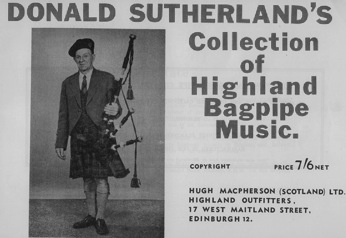 The title page of Donald’s book, 1960.
The title page of Donald’s book, 1960.
Donald and John’s eldest brother, Neil, who was also a piper, homesteaded East of Billings, Montana. Donald worked on Neil’s ranch for a while after leaving Australia. John’s son, Neil, told me his uncle Neil gained a lot of the land around his holdings by cutting off the water supply to his neighbors and then buying them out. He carried a pistol at all times. Donald made a slow march called “Neil Sutherland’s Farewell to the E-U Ranch” which is published in his book.
While in Montana, Donald became familiar with A.K. Cameron, a pibroch enthusiast who wrote many letters to the Oban Times and was inspired by Simon Fraser of Australia. Donald acquired Cameron’s copy of Angus MacKay’s collection of pibroch, annotated heavily with remarks by Cameron concerning Fraser’s ideas. It also contains remarks by Ronald MacKenzie and Thomas Mor MacKenzie. Cameron wrote in a beautiful, well practiced script. Donald had met and studied with Fraser and his son, Hugh, while working in Australia in the 1920s. He wrote a detailed description of Fraser’s style, emphasizing proportion and rhythm. Many of the embellishments he describes and their timing would be considered either out of date or simply wrong today. Still, what Donald describes is a kind of pibroch that is integrated, bold, balanced and rhythmical. It is easy to imagine the influence Donald may have had on the ideas developed later by his friend, James MacColl.
Farquhar Ewen Finlayson, circa 1920
Donald returned to Montana in 1930 where he worked on Tom Mor MacRae’s ranch near Cohagen, Montana. Other pipers working on the ranch included Farquhar Ewen Finlayson (who was famous in New Zealand), A.K. Cameron, John and Donald Renwick (Tom MacRae’s brothers in law), and Kenneth MacDonald. Finlayson and the Renwicks were cousins.
Donald Sutherland kept a handwritten copy of the obituary for Farquhar Ewen Finlayson from the New Zealand Scotsman, dated February 15, 1930, in his KILBERRY BOOK OF CEOL MOR. It stated: “The delights and triumphs of his piping bouts were as nothing to him compared with his joy and satisfaction in having seven of his own pipe tunes chosen for and published in Logan’s famous collection of bagpipe music.” He died at the age of forty six and is buried in Rockwood, New South Wales, Australia.
David Charles Mather immigrated to Montana in 1901. He was born in London in 1868 and died in Bozeman, Montana, in 1943. His father was invalided out of the Durham Light Infantry after being wounded in the Crimean War. John V. Pearson discovered that Mather’s mother, Mary Ann Holland, was from Ireland. He was nicknamed the “Cockney Piper” because he grew up in London at the Caledonian Boys School.
He studied piping with Robert Meldrum, Pipe Major of the 93rd Highlanders, and Ronald MacKenzie, Pipe Major of the 78th Highlanders. Meldrum studied pibroch with Calum “Piobaire” MacPherson and taught John MacColl. MacKenzie was the nephew of John Ban MacKenzie and an associate of Alex (Sandy) Cameron. George S. McLennan’s brother D.R. told Pearson that George felt that Mather never received the success he deserved in competition. Mather was a very active competitor in both piping and dancing from 1890 to 1900, taking many 1st prizes including Gold Medals in pibroch at Oban in 1891 and Inverness in 1894 and 1899.
Pipe Major William H. Wallace and D.C. Mather at Mather’s claim in Norris, Montana, shortly before his death in 1943 (Larry Erdmann collection).
Mather was probably the first piper from outside the Highlands to earn the highest awards in piping. That distinction usually goes to Robert Reid (born 1895), who observed that pibroch was perfected in Glasgow, not the Highlands.
We can only speculate why Mather left Scotland for Montana, but at that time many of the gentry who once employed pipers could no longer afford them due to tax law reform. At the same time many pipers dropped out of competition when performance styles became standardized. Mather was employed as an estate piper by Lt. Col. John Stewart MacDougall of Lunga, Admiral Colin Yorke Campbell of Barbreck, and Lady Ann and Mr. Charles Murray of Lochcarron. One reason put forward but as yet unsubstantiated is that Mather suffered from a broken heart from an unsuccessful marriage.
Mather lived and worked in mining operations near Anaconda, about fifty miles from Butte, Montana. Scottish pipers would rendezvous in Butte to talk piping and learn from Mather. Mather gave up piping for about twenty years to follow his vocation as a Jehovah’s Witness preacher, but he also suffered from a lung disease contracted in the mines. He played a set of miniature pipes and the practice chanter up until his last days.
D.C. Mather as a young man (photo unknown)
One of the great finds in the Sutherland manuscripts is an unpublished 6/8 march poorly written out in 2/4 with a note attributing it to Mather (see page 5). I sent a copy of the tune to Neil Stubberfield of Powell River, B.C., who studied with Mather for three years in the early 1940s. He remembered the tune as being called “Tulloch” so that is its name in this collection. In a letter to me Stubberfield wrote, “He was a man of seventy years old, but still one of the sweetest piobaireachd players I have had the pleasure of listening to. He didn’t always play tunes in the settings we have today, but said they were the old settings that he was taught.”
Tom Mor MacRae studied piping in Scotland with Ronald MacKenzie and Donald MacPhee before homesteading in Montana. When recruiting men from Scotland to work on his sheep ranch near Cohagen, Montana, he chose pipers from near his home in Kintail and the surrounding area. Most of the pipers in Montana at the time came from the Highlands in Scotland around Loch Duich, Lochalsh, Torgormack, and Beauly.
Donald Sutherland learned to make pipes while working for Tom MacRae. Colin MacRae said he made more than three sets of pipes. He made one from the oak of a wagon pole that had come across the Oregon Trail. None of the sets of pipes made by Sutherland have come to light, but the search continues.
Donald Sutherland with his oak bagpipes, circa 1955
Donald at different times lived in Silverton, Glide, Lakeview and North Powder, Oregon. He became great friends with Colin MacRae, who lived near Portland in the 1950s and whose father was from Inverinate on Loch Duich and had worked in Montana as well. Colin would play Donald’s pibroch compositions back to him so he could hear how they sounded.
Donald was also inspired by Calum Piobaire and his son Angus MacPherson, who lived in Inveran not far from the Sutherland croft. It was sometimes said that the Sutherlands were related to the MacPhersons, but Donald refuted this claim in a letter to the Oban Times in 1961. Donald was very proud of his association with the MacPhersons, however, and named two of his surviving pibrochs after them.
Angus MacPherson said in an interview with John Pearson in 1974 that he remembered competing with the Sutherlands in the early 1900s. They were “fine men,” he said, but Donald was an “ordinary piper.” Donald sent tapes of his piping to The Army School of Piping at Edinburgh Castle where they were deemed unworthy of preservation and erased. One tape he sent to Calum MacPhee was played at a meeting of The Highland Pipers’ Society.
A ‘scrapbook’ page from Donald’s Kilberry book of Ceol Mor. The photo in the upper left corner shows a shepherd’s trailer or caravan.
Donald’s book contains several tunes that have become classics. His Edinburgh based publisher, Hugh MacPherson, clearly judged him a worthy piper and composer. Donald never achieved acclaim in competition, but that should not be held against him because winning prizes and fame is not a precondition for making beautiful music. His generous devotion to the music is unquestionable. Donald worked all of his life under the most difficult conditions for developing piping skills. Long days of rough work and constant exposure to the elements were hard on body and soul. Shepherds in those days lived in small trailers like Travelers’ caravans and were often completely alone for months at a time. Donald pasted articles, letters and photos in his pibroch books. One page showed the shepherd’s typical home.
John W. Sutherland, like his brother, Donald, was an athlete, and competed successfully in sporting events in Scotland. A clipping from The Northern Times, hand dated 1910, found in Donald’s copy of THE KILBERRY BOOK OF CEOL MOR states, “Mr. Donald Sutherland and his brother (J.W.), two outstanding athletes, gave weightlifting exhibitions at a concert in the local Drill Hall. A prize offered to anyone in the audience who could emulate their feats was not won.” He was educated and so avoided hard physical work by teaching mathematics in a High School near Portland, Oregon. He coached track and taught piping at Colin MacRae’s Oregon College of Piping.
John’s compositions reveal an accomplished and talented piper, one with a very keen understanding of the subtleties of the music. He spoke to Colin MacRae of putting a book together but it never came about. It is tempting to speculate that John did not want to show up his older brother because John’s compositions are, perhaps, more exciting and accomplished than Donald’s. According to his son, Neil, John was a shy man who was not one to put himself before another. Most of his tunes are named for places near his home in Sutherland, so his music was probably a private and nostalgic pleasure.
In his day, a piper with little or no reputation as a competitor in Scotland could not hope to gain much attention for composition, and even risked ridicule among the piping elite in Scotland and elsewhere. As the quote from Angus MacPherson illustrates, many piping authorities in Scotland were quick to dismiss “exiled” pipers as “ordinary.” I think John was a person with humility and lacked Donald’s ambition for recognition in the larger world of piping. Although he was an eager and generous teacher of piping, John had no interest in participating in pipe bands or solo piping competition.
John’s children, Merilyn and Neil Sutherland, Kent, Washington, 1996. (Photo by John Dally)
Neil said his father composed hundreds of tunes, especially pibroch, also known as ceol mor and piobaireachd. One of his favorite pastimes was playing them on the practice chanter. He liked to circle the house playing them on the big pipes. Before he died John instructed his wife to burn all the tunes he had made. Fortunately, not all of John’s tunes were lost in that fire. Sadly, none of his pibroch tunes survived. John had a very deep appreciation for pibroch judging by the copious and minute notes he made in the margins of his pibroch books, filling many of the folio sized pages from top to bottom with small, often mathematical scribbles. Colin MacRae remembers a tickertape kind of machine that John invented to measure the precise length of notes in the tunes he received on reel to reel tapes from friends in Scotland. If the melodies of his marches are any indication of his talent as a composer, then the severity of the loss of his pibrochs is very great, especially as it represents an integral part of the legacy of piping tradition in the Pacific Northwest.
According to Neil no photos of John exist because he was a private and shy person. Colin MacRae speculated that John may have felt circumspect about photographs, like many of the Gaels of his day. Neil said he was “not a joiner” and did not care for Scottish cultural organizations.
Many of John’s tunes in this volume were deciphered from slight or partial notations in a faint and tiny hand, usually in pencil, and sometimes on scraps of paper. In some instances only the heads of the notes are visible, and in most of the cases timing and gracing are missing. As the editor of John’s work I have made every effort to present the tunes in the best way possible. Settings are personal and often variable, in spite of the strict adherence most pipers give to endorsed settings in competition. Other interpretations of John’s tunes are encouraged as long as they treat the compositions with respect and credit the source. The most important purpose of this book is for John’s work to be made available to pipers everywhere for the first time.
The Sutherland family tree (John W. Sutherland marked by “x”):
One of John Sutherland’s more complete tunes: “Loch Garve”.
Colin MacRae
Researching the Sutherland manuscripts led me to Colin MacRae, who became my piping teacher. His knowledge of piping, the Montana pipers and their tradition, the Sutherland brothers, as well as his friendship and encouragement, made this book possible. His guidance was crucial in the interpretation of the works contained in this book.
Colin’s father, Alexander MacRae, was born in Inverinate, Loch Duich, near the famous castle of Eilean Donan. Alex received instruction in piping while in the Gordon Highlanders. He immigrated to Montana, where he met his wife, who had immigrated to Montana from England. They built a house in West Seattle that became a meeting place for pipers. He was a founding member of The Seattle Pipe Band and The Washington Scottish Pipe Band.
Pipe Major Ronald MacKenzie, Seaforth Highlanders, circa 1890, CEOL MOR.
Like Donald and John, Alex’s mother tongue was Gaelic, but Gaelic speakers rarely spoke in Gaelic because of the treatment they had received in Scottish schools and in Scotland beyond the Gaeltacht. They only used it in private, hushed conversation. They did not encourage their children to speak Gaelic. The Gaelic poet, Evan MacColl, described how school children were punished for speaking Gaelic in school by having to wear a horse’s skull around their necks.
Colin’s father’s friend, Tom Gourley, convinced Alistair MacMillan in Tacoma, Washington, to take Colin as a student in 1939. Colin continued taking lessons, which often lasted six hours and included dinner, until MacMillan died in 1950. MacMillan was known as Alec and worked at a smelter near Point Defiance. Colin traveled by bus from West Seattle to Tacoma for these lessons, until he was old enough to drive. Colin said Alec would point to a score of pibroch, saying, “Those are the notes. Now I’ll teach you the music.” Like D.C. Mather, Alec played a style of pibroch that went out of fashion when the Piobaireachd Society settings were made mandatory for competition.
MacMillan was born in Colonsay, had been a top level competitor in Scotland, and was one of the last estate pipers. John MacColl was his principal teacher, but he was also well acquainted with Robert Meldrum and John MacDougall Gillies. He won the Silver Star in 1903. He continued to stay in contact with Meldrum and MacColl for many years after emigrating to the U.S. He helped many Northwest pipers get sets of pipes selected by Meldrum and MacColl. Alec composed a tune, “Kiloran Bay,” which celebrates a beautiful place on Colonsay.
Pipe Major Robert Meldrum at the Aboyne Games, 1930.
Just prior to emigrating, MacMillan lived in London with his friend, P.M. Willie Ross. Ross included “Kiloran Bay” on page 5 of BOOK 3 of his collections of tunes. Alec told Colin that the tune was not printed the way he composed it. The same volume includes D.C. Mather’s reel, “The Man from Glengarry” which he composed for a fellow prospector from Glengarry, Ontario.
Colin MacRae, Seattle, Washington, 2007.
Through Alec, Colin absorbed an approach to pipe music that included much more than style. Alec’s knowledge of pibroch predated the Piobaireachd Society prescribed settings, but more importantly it came from a time when pibroch was a vital social and cultural phenomenon in the broader community outside the competition arena. General Thomason asked him to proofread his crucial text, CEOL MOR, a fact that demonstrates the depth of his knowledge. Colin is as direct a link as we are likely to find today with the musical traditions of the great Victorian and Edwardian pipers whose playing was made redundant by institutions such as the Piobaireachd Society whose published settings of tunes and technique are followed to the grace note by competing pipers.
With that in mind, Slighe nan Gaidheal gave us a grant to have Ronald MacKenzie’s manuscripts in the National Library of Scotland photographed and put onto microfiche. I printed hardcopies from the microfiche at the Suzallo Library at the University of Washington. A few tunes from these manuscripts appear in this collection. We have yet to fully examine the hundreds of pages, but research reveals several interesting things, especially with regard to John Ban MacKenzie’s compositions. Gracing and timing indicate a fluid, lively approach to light music. One of the big surprises was the discovery of a reel, “Murdock’s Daughter” (see page 69), which employs syncopation in the third part.
Colin MacRae & Rona MacDonald Lightfoot backstage at the Feis 2000 concert, Seattle (John Dally)
Colin MacRae is only once removed, through his father and Alec MacMillan of Colonsay, from some of the greatest pipers: Ronald MacKenzie, Sandy Cameron, Calum MacPherson, D.C. Mather, Ronald Meldrum, John MacDougall Gillies, and John MacColl. Old piping styles found shelter outside the piping mainstream. From MacMillan Colin learned a style of piping that was old before he was born. He remained loyal to the techniques, rhythms and song-based style of playing pibroch taught to him in spite of tremendous pressure to modernize.
Colin teaches playing with strong fingers. He will often play an open ‘c’ in order to get a bold sound going from ‘c’ to low ‘a’ with a ‘g’ grace note in between, something nearly impossible to do playing a closed ‘c.’ He notes that the modern way of playing ‘edre’ as ‘drey’ ruins too many tunes. The controversy over the so called ‘redundant low ‘a’’ in pibroch makes Colin chuckle. He was taught that there are a number of different ways to play taorluaths, crunluaths and other pibroch embellishments. He believes the kind you use and how you accent it depends on the tune and how you choose to express it. There are different ways to accent the ‘hiharin,’ although only one style, incorporating a burl, is played today. Some of the various ways are illustrated in the front matter of CEOL MOR.
John MacDougall Gillies (photo unknown)
Colin believes that it is impossible to express a tune without knowing its history. Colin observes that differences between laments, salutes, gathering tunes, battle tunes and rowing tunes are overlooked by many pipers today. He identifies “Scarce of Fishing” as a pastoral piece. Several other tunes belong to the mocking type. Serious research is being done to identify the “gentry” these mocking tunes were named after, but Colin was taught they were made to mock individuals who only pretended to be gentry. He will not play those tunes because their intent is malicious.
Colin does not give much credence to the ideas of Simon Fraser, Australia, unlike Donald Sutherland and A.K. Cameron. Although he respects Fraser’s ideas on form, Colin does not believe that pibroch form is absolute or that tunes need to be corrected to fit abstract formulae by adding or subtracting bars of melody. Melodies do fit within certain modes and scales, however, so holding on to cadences at the expense of melody notes is disapproved of by Colin.
Two pibrochs written down in Ronald MacKenzie’s manuscripts, “MacLeod of Raasay’s Salute” and “MacIntosh’s Lament,” reveal a remarkable similarity to Colin’s settings while differing from Piobaireachd Society settings. He is fond of David Glen’s COLLECTION OF ANCIENT PIOBAIREACHD, but refers to his annotated copy of CEOL MOR that was given to MacMillan by Thomason for any given tune.
An eyewitness said, “Mr. Mather’s marching as he played was very different from the steps of the other pipers. He took very short, quick steps with a spring to them.” Colin’s approach to marches is much the same, quick and jaunty compared to today’s norms. His strathspey and reel playing are also quick with heavily accented first beats in the bar. His style is marked by rubato, what he describes as “putting the song into it.” He likes rhythmic piping with lots of lift, and dislikes what is sometimes called “typewriter” piping, a metronomic and technical way of playing. He feels the soft fingering practiced by most pipers today does not allow for the subtle manipulation of notes and embellishments afforded by the muscular fingering style he learned. He does not approve of sliding from one note to another, c naturals, or many of the modern trends in taste and technique.
Inseparable from the unique style of Colin’s playing is an ethic of putting the music first and remaining loyal to the pipers who taught him his art.
Colin MacRae (Colin MacRae collection)

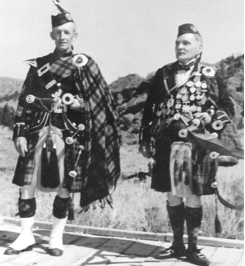
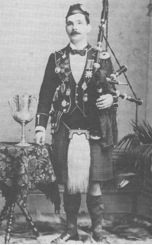
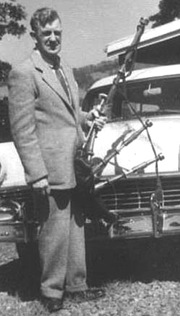
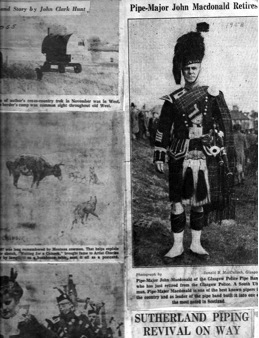
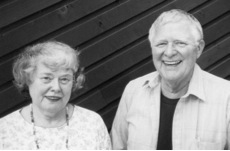
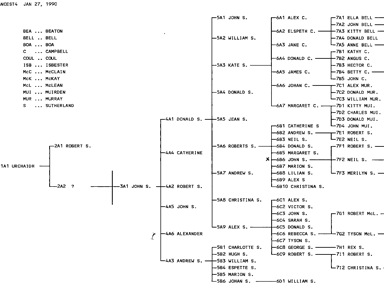
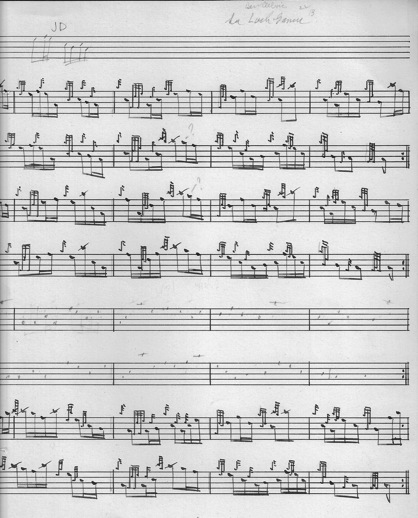

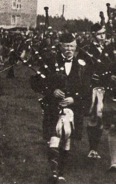
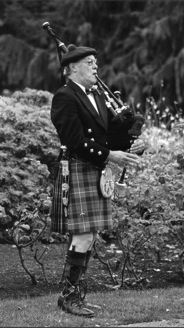
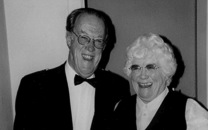
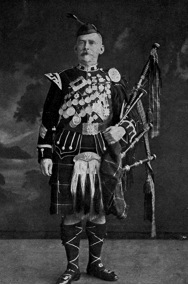
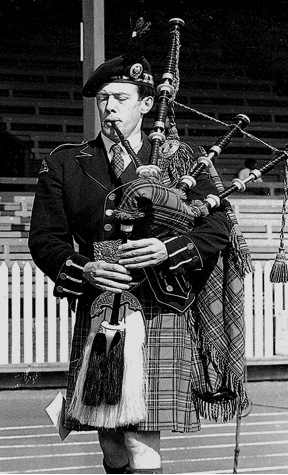
Hey! I just wanted to ask if you ever have any issues with
hackers? My last blog (wordpress) was hacked and I ended up losing a few months
of hard work due to no backup. Do you have any methods to stop hackers?
Not that I’m aware of.